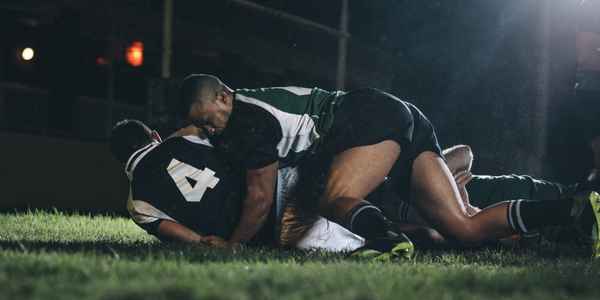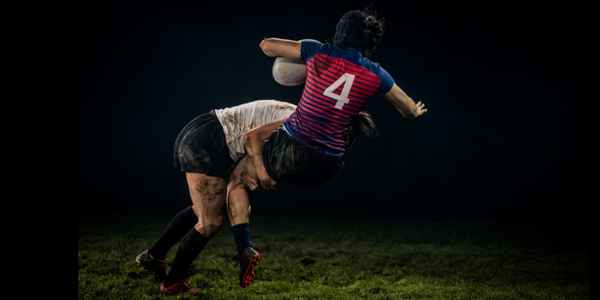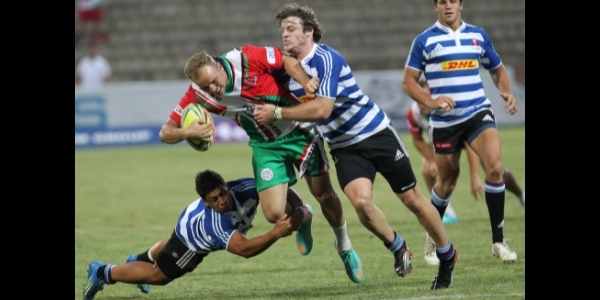G-force is used to measure the force of impact of rugby tackles. Two studies of amateur players found that they experience an average impact of 21-22 g when tackled. The hardest tackle was clocked at 205 g.
A tackle in a Six Nations match between Ireland and Wales in 2014 measured 27 g.
This article looks in more depth at both academic studies. We’ll also show you that big hit from international rugby. You may be surprised to find that the tackler was the one who had to go off injured!
But first, we’ll explain g-force with examples from normal life to extreme circumstances.
Using G-Force To Measure Rugby Hits

G-force is a measure of acceleration or deceleration relative to Earth’s gravity.
If you are sitting on a couch right now, you are experiencing 1 g of force from Earth’s gravity pushing against you. That’s the baseline.
If you sneeze, you experience about 2 G.
Now, let’s make things more interesting by looking at the kind of gees that racing car drivers experience. When the drivers are decelerating to take a corner, they experience about 5 g.
Examples of g-force from car crashes
When a normal car crashes at about 65 Km/h, the force is about 35 g.
But what about racing cars? I don’t want to be insensitive, so every driver survived the next examples I’ve picked.
In a spectacular crash in 2021 at Silverstone, Max Verstappen’s car spun into the tyre barriers at 51 g. He was briefly knocked out but recovered quickly.
In the 2007 Canadian Grand Prix, Robert Kubica’s car hit the wall at 75 g. He was concussed and sprained an ankle.
In the 2003 Texas Motor Speedway, Kenny Brack’s crash measured 214 g. That is the highest horizontal g-force that a human has survived.
Brack was seriously injured but returned to racing the following year.
How do scientists measure g-force in rugby?
With all that instrumentation in racing cars, you’ve probably guessed that they readily collect g-force data.
But what about rugby players? Some research studies used special mouthguards with tiny accelerometers installed within them.
That was before the relatively recent introduction of GPS trackers into the sport. We have an article on GPS tracking in rugby if you want to know more about the technology and what it can do.
New Zealand Study That Measured The G Force Of Rugby Tackles

One of the first major studies on g-force in live matches was conducted in New Zealand in 2013.
Doug King led a research team that worked with the Hutt Old Boys Marist club. The players were provided mouthguards with special instruments to measure the g-force to their heads in collisions.
Before I give you the average g-force, I want to point out that the study only measured impacts that were at least 10 g. This was to eliminate the gees from running and jumping.
But I wonder if this inflated the average in this study. Anyway, let’s get to it.
The King study found that the average force of tackles in amateur matches was 22 g.
Highest recorded Gees in King’s study
The highest tackle was measured at an astonishing 205 g. That is approaching the Texas Motor Speedway crash at 214 g that put the driver into hospital with several fractures.
But both the tackler and the ball carrier were uninjured in this tackle.
During the study across 19 matches, there were two concussions on the pitch. Dr. King actually excluded the measurements from these tackles from his averages.
However, the gees make for interesting readings. In one of the collisions that resulted in a concussion, the ball carrier was double-tackled with a third defender close by.
- The first tackle was side-on from the left and registered 98 g
- The second tackle was within milliseconds from the right and registered 160 g
That second tackle knocked the player’s head against the shoulder of a third defender. That was what caused the concussion.
Interestingly, this third hit registered the lowest of the three at 70 g. But it’s easy to understand why that’s what knocked the player out.
American Study Had Similar Results

Six years after Doug King’s work was covered by the New York Times, another research study was conducted at an American college.
This study compared the impact of tackles between rugby and American football. Unlike King’s research, the measurements were taken during practice sessions of college rugby and football players.
The football players had sensors added to their helmets. The rugby players were given mouthguards with sensors. Here were the results:
- The average collision impact on the football players was 63 g.
- The average for the rugby players was 21 g.
That number for these college rugby players is very similar to King’s study.
How Hard Are Professional Rugby Hits?
If you’re like me, you’re thinking – okay, that’s amateur rugby. What about those hits we see in Super Rugby or international matches?
I mentioned that most professional clubs now use GPS to track all kinds of measurements during training and matches. They certainly have the g-force but they tend not to release that kind of information.
This is partly because the media has reported sensational numbers without giving context.
But we do have an example from one of the greats of the game.
Brian O’Driscoll wrote in his autobiography about a tackle in the 2014 Six Nations. Scott Williams of Wales hit the Irish centre with a force measured at 27 g.
O’Driscoll is clearly in some discomfort afterward and takes a while to get up. As he walks away, he turns and gives a wry smile to the tackler.
However, it was Scott Williams who had to go off injured from that tackle. O’Driscoll was in the act of passing when tackled, and Williams’ shoulder hit his elbow.
The Welshman had to leave the field with a busted AC joint. But he has spoken of how much he values the shirt that O’Driscoll handed to him after the match.
Not All Tackles Are Big Hits
We’ve focused in this article on the big hits that have the most force in rugby.
But these are just a small percentage of all the tackles that take place in a single rugby match. For example, chasing after a player and tackling from behind will produce less Gs.
You may be surprised to learn that there are many different types of tackles in rugby. The linked article describes eleven!